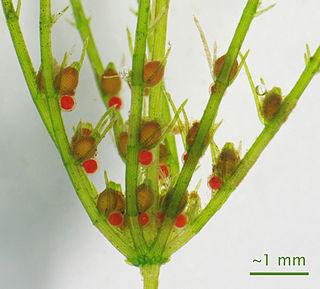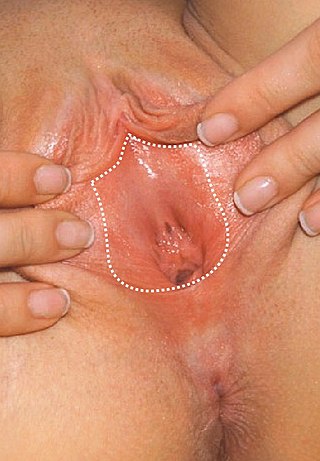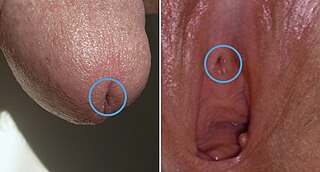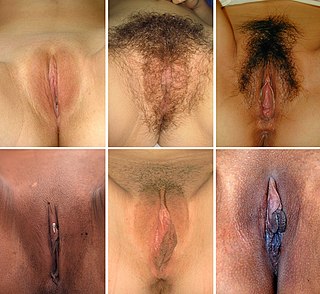A vulva (plural: vulvas or vulvae) is the region containing external genital organs on female mammals.
Contents
Vulva may also refer to:
A vulva (plural: vulvas or vulvae) is the region containing external genital organs on female mammals.
Vulva may also refer to:

The labia minora, also known as the inner labia, inner lips, or nymphae, are two flaps of skin that are part of the primate vulva, extending outwards from the inner vaginal and urethral openings to encompass the vestibule. At the glans clitoris, each labium splits, above forming the clitoral hood, and below the frenulum of the clitoris. At the bottom, the labia meet at the labial commissure. The labia minora vary widely in size, color and shape from individual to individual.

A sex organ, also known as a reproductive organ, is a part of an organism that is involved in sexual reproduction. Sex organs constitute the primary sex characteristics of an organism. Sex organs are responsible for producing and transporting gametes, as well as facilitating fertilization and supporting the development and birth of offspring. Sex organs are found in many species of animals and plants, with their features varying depending on the species.

In female humans and other mammals, the clitoral hood is a fold of skin that surrounds and protects the glans of the clitoris; it also covers the external clitoral shaft, develops as part of the labia minora and is homologous with the foreskin in the male reproductive system. The clitoral hood is composed of mucocutaneous tissues; these tissues are between the mucous membrane and the skin, and they may have immunological importance because they may be a point of entry of mucosal vaccines.

Epididymal hypertension (EH), informally referred to as blue balls for males or blue vulva for females, is a harmless but uncomfortable sensation in the genital regions during a prolonged state of sexual arousal. It usually resolves within hours unless relieved through an orgasm.
Atrium may refer to:

The human female reproductive system is made up of the internal and external sex organs that function in the reproduction of new offspring. The reproductive system is immature at birth and develops at puberty to be able to release matured ova from the ovaries, facilitate their fertilization, and create a protective environment for the developing fetus during pregnancy. The female reproductive tract is made of several connected internal sex organs—the vagina, uterus, and fallopian tubes—and is prone to infections. The vagina allows for sexual intercourse, and is connected to the uterus at the cervix. The uterus accommodates the embryo by developing the uterine lining.

The genitourinary system, or urogenital system, are the sex organs of the reproductive system and the organs of the urinary system. These are grouped together because of their proximity to each other, their common embryological origin and the use of common pathways. Because of this, the systems are sometimes imaged together. In placental mammals, the male urethra goes through and opens into the penis while the female urethra and vagina empty through the vulva.

The male reproductive system consists of a number of sex organs that play a role in the process of human reproduction. These organs are located on the outside of the body, and within the pelvis.

The labia are the major externally visible structures of the vulva. In humans and other primates, there are two pairs of labia: the labia majora are large and thick folds of skin that cover the vulva's other parts, while the labia minora are the folds of skin between the outer labia that surround and protect the urethral and vaginal openings, as well as the glans clitoris.

Labiaplasty is a plastic surgery procedure for creating or altering the labia minora and the labia majora, the folds of skin of the human vulva. It is a type of vulvoplasty. There are two main categories of women seeking cosmetic genital surgery: those with conditions such as intersex, and those with no underlying condition who experience physical discomfort or wish to alter the appearance of their vulvas because they believe they do not fall within a normal range.

The vulval vestibule is the part of the vulva between the labia minora. At the innermost part are the vaginal introitus and urinary meatus. The Bartholin's and Skene's glands each have two openings to the vestibule on the inside. The outer edge, marked by a coloration difference in the tissues, is called Hart's line, named after David Berry Hart.

Sexual differentiation in humans is the process of development of sex differences in humans. It is defined as the development of phenotypic structures consequent to the action of hormones produced following gonadal determination. Sexual differentiation includes development of different genitalia and the internal genital tracts and body hair plays a role in sex identification.

The urinary meatus, also known as the external urethral orifice, is the opening of the penis or vulva where urine exits the urethra during urination. It is also where semen exits during male ejaculation, and other fluids during female ejaculation. The meatus has varying degrees of sensitivity to touch.
The development of the reproductive system is the part of embryonic growth that results in the sex organs and contributes to sexual differentiation. Due to its large overlap with development of the urinary system, the two systems are typically described together as the genitourinary system.
The reproductive system of an organism, also known as the genital system, is the biological system made up of all the anatomical organs involved in sexual reproduction. Many non-living substances such as fluids, hormones, and pheromones are also important accessories to the reproductive system. Unlike most organ systems, the sexes of differentiated species often have significant differences. These differences allow for a combination of genetic material between two individuals, which allows for the possibility of greater genetic fitness of the offspring.

Clitoral hood reduction, also termed clitoral hoodectomy, clitoral unhooding, clitoridotomy, or (partial) hoodectomy, is a plastic surgery procedure for reducing the size and the area of the clitoral hood in order to further expose the glans of the clitoris.

Lipschütz ulcer, ulcus vulvae acutum or reactive non-sexually related acute genital ulcers is a rare disease characterized by painful genital ulcers, fever, and lymphadenopathy, occurring most commonly, but not exclusively, in adolescents and young women. Previously, it was described as being more common in virgins. It is not a sexually transmitted infection, and is often misdiagnosed, sometimes as a symptom of Behçet's disease.

In mammals, the vulva comprises mostly external, visible structures of the female genitalia leading into the interior of the female reproductive tract. For humans, it includes the mons pubis, labia majora, labia minora, clitoris, vestibule, urinary meatus, vaginal introitus, hymen, and openings of the vestibular glands. The folds of the outer and inner labia provide a double layer of protection for the vagina. Pelvic floor muscles support the structures of the vulva. Other muscles of the urogenital triangle also give support.
Pruritus of genital organs may refer to: